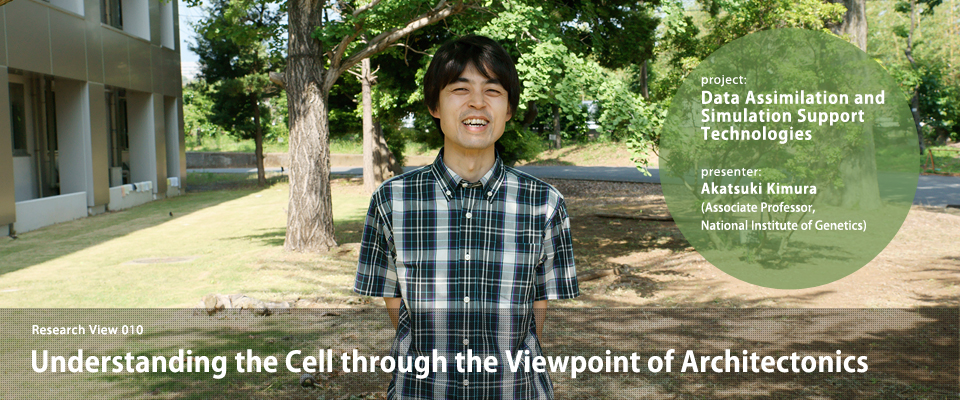
Associate Professor Akatsuki Kimura (National Institute of Genetics) is participating in the research commons “Data Assimilation / Simulation Support Technology” project led by the Institute of Statistical Mathematics. Professor Kimura says, “When I was a graduate student, I was a typical “lab brat” who never considered Mathematics to be my strong suit. At that time, I was engaged in histone modification research, which was still in its stages of inception. When I was considering how the boundaries of chromosomal domains are form, I felt an urge to investigate our hypothesis derived from our experiments from a theoretical aspect. Mathematical calculation enables researchers to check whether their hypotheses are sufficient. If our best hypothesis turned out to be insufficient, this leads to a new discovery. Prof. Kimura chose his current environment as a place where such research is possible, and is now pursuing “data centric science,” a methodology spreading fast to many scientific fields. The nematode is the most utilized model animal in his lab.
Why statistical mathematics matters to cell biologists?
We are engaged in cell biology. Cells are the smallest unit of life and can be considered the boundary between a living entity and a non-living one. I would like to study the various aspects of cell behavior. Obviously, our understanding of cells would be greatly aided if we could create one ourselves. Unfortunately, this is still very difficult and hence we are trying to create a cell in a computer. In order to create a computational model, we first use microscopy to extract rich data such as 3-D positioning of the nucleus and other cellular components and their temporal development. This brings our research into the domain of statistical mathematics, leading to the methodology known as “data centric science,” which infers models and/or their parameters from data. Big data, a recent hot topic, has also become extremely important in the world of cell biology.

The return of old-school “cell architecture studies”
The development of microscopes around a hundred years ago initiated a research period wherein cells were recorded through careful sketching with physical manipulations. However, the sudden development of molecular biology around 50 years ago attracted most cell biologists to this discipline. The kind of research abandoned in favor of molecular biology was novel for scientists of my generation. Perhaps, conbining the classical approaches with the molecular biology tools available nowadays will bring a breakthrough in the field. Most cell biologists pay too much attention to molecular level understandings. I believe more researchers should see cells as they are, at the scale of cells. Maintaining the spirit of old researchers simultaneously while taking advantage of the available new tools, I have named my research as “cell architecture studies.” However, since this kind of cell-level research is not well established compared to the molecular-level research, we have to start from the consideration of appropriate methodologies. Similar to planning a mountain climb where a strategy involving the route and the design of your ascent is scrutinized in details, you can only plan research that you are in a position to carry out.

Analyzing “cytoplasmic streaming” via data assimilation
A recent product of the “Data Assimilation/Simulation Support Technology” project is research into a cytoplasmic streaming of the nematode, Caenorhabditis elegans. As a result of cell division, two identical cells are usually produced. But in some cases, cells of a different character is created, which is called asymmetric cell division. In C. elegans, when an asymmetric cell division occures, cytoplasmic streaming creates asymmetric localization of cellular components. How much forces are generated at which location to drive this cytoplasmic streaming? Since forces inside a cell are difficult to be measured directly, we are trying to estimate forces using Data Assimilation. In this analyses, we estimate the probability density function of force distribution to reproduce the streaming observed inside the cell quantitatively.

Data assimilation is useful to many cell biology problems
Excited by the results of such research commons, we are tying up with various laboratories researching other organisms to apply the data assimilation method. For example, in genetics research, it is a standard approach to create a cell lacking the function of a specific gene in order to find out the role of that gene. The differences between the original and the newly created strain are investigated to determine differences between the two. However, in reality this process starts when a scientist notices such differences by adopting a particular test. Instead of searches depending on a scientist’s intuition, it might be useful that computers systematically search for differences in model parameters underlying a phenomenon using the data that already exists. I hope it is not an exaggeration to say that joint research under the ‘data centric science’ banner has the potential to transform the way in which genetics research is carried out. The joy of this method lies in simply collecting data in a proper manner, which leads to the completion of tasks in a relatively short time, and allows us to tackle a wide range of organisms. Such joint research allows us to seek out lines with statistical integrity that can be tested experimentally. I am looking forward to spreading news of this method to researchers in various biology fields.

(Text in Japanese: Akatsuki Kimura, Rue Ikeya. Photographs: Mitsuru Mizutani. Published: August 11, 2014)




